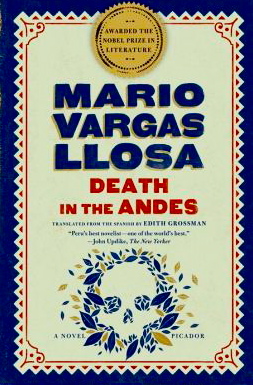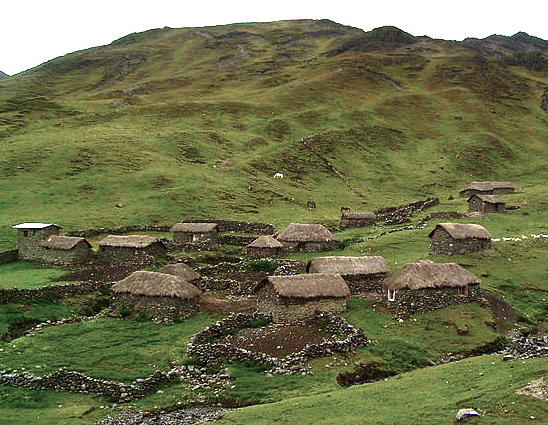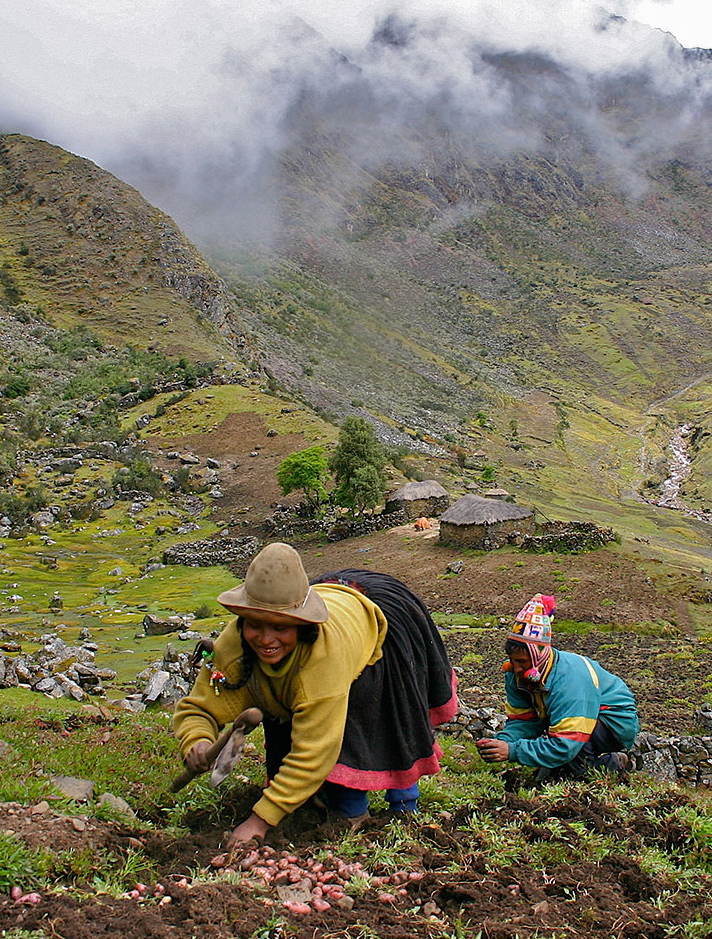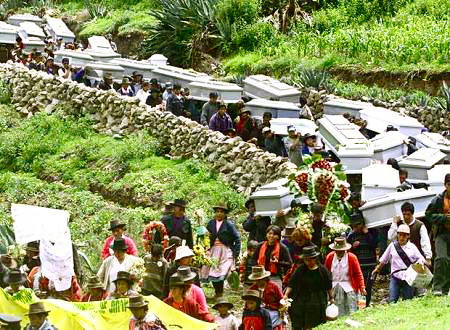Note: Mario Vargas Llosa was WINNER of the Nobel Prize for Literature in 2010.
“People are really scared, have you noticed? At the cantina, on the job, all the work crews. Even the Indians who haven’t left the community yet. There’s tension in the atmosphere, like something is about to happen. Maybe it’s the rumor that they’re stopping work on the highway, that they’ll all lose their jobs. And all the killing everywhere. Nobody’s nerves can take it…Don’t you feel it?”—Tomasito, adjutant in the Gardia, to his boss, Cpl. Lituma.
 Nobel Prize winner Mario Vargas Llosa continues to speak out politically in yet another realistic and uncompromising novel set in his home country of Peru. In this novel, he brings the reader face to face with the horrors of the Shining Path (Sendero Luminoso), a Maoist terror group operating in the mountains of Peru from the early 1980s to the mid-1990s, with seemingly few direct challenges from the government. The novel’s sense of immediacy, enhanced by vivid descriptions of real events affecting real people, provides a close-up look at the tactics, including massacres, used by the Shining Path in the central and southern mountains of Peru, where they attacked indigenous Indian peasants, all foreigners, all educated Peruvians working to improve the lives of the peasants by providing better services, and anyone representing the government or police.
Nobel Prize winner Mario Vargas Llosa continues to speak out politically in yet another realistic and uncompromising novel set in his home country of Peru. In this novel, he brings the reader face to face with the horrors of the Shining Path (Sendero Luminoso), a Maoist terror group operating in the mountains of Peru from the early 1980s to the mid-1990s, with seemingly few direct challenges from the government. The novel’s sense of immediacy, enhanced by vivid descriptions of real events affecting real people, provides a close-up look at the tactics, including massacres, used by the Shining Path in the central and southern mountains of Peru, where they attacked indigenous Indian peasants, all foreigners, all educated Peruvians working to improve the lives of the peasants by providing better services, and anyone representing the government or police.
The novel opens with an old woman, who speaks only Quechua, telling Tomas (Tomasito) Carreno, the assistant of Corporal Lituma at their small Gardia station in Naccos, that her husband has disappeared. What is worse: she had expected something to happen to him. Her husband, a foreman on a road-building crew, is the third person from their small mountain village to have disappeared in the past three weeks, the other disappearances also remaining a mystery. Local peasants, farmers, laborers, and Indians have provided no information to Tomas or Lituma, and both men worry that they are surrounded by the terrorists they are there to monitor. The local people have learned from past experience that government forces are not always to be trusted, so Tomas and Lituma are virtually alone at this station. Lituma is a man from the coast, and he has little understanding of the local mountain culture, never sure if he is being teased at the cantina when villagers talk about lightning as the “lizard of the sky,” about earthquakes as the work of the devil, about pishtacos – man-monsters who kill men and suck out their body fat for cannibalistic purposes. The locals often leave plates of food for serpents at the mouths to caves.
Without transition, the narrative suddenly shifts to a pair of young, naïve French tourists who have chosen to go through the Andes by local bus to their next destination, instead of by plane. “Michele” is uncertain, but she goes along with “Albert,” a teacher, who is interested in native music, and who believes, even after masked men stop the bus, that this will be an experience which they will love sharing with their buddies back home in France – when it is all over. They believe that nothing can happen to them because “We are French tourists, senor.” Other story lines also evolve and broaden the scope. Twenty-three-year-old Tomasito, the adjutant to Lituma, is in the mountains to escape death at the hands of a mob leader in Tingo Maria for whom he had been a bodyguard – until he fell in love with his boss’s girlfriend. Many people now want him dead. The man who runs the cantina and his wife, thought to be a witch, play all sides of all issues in an effort to make money, and cannot be trusted, though they hear everything that is going on.
Of the three missing men, one case makes Lituma feel particularly guilty, the disappearance of a “little mute,” whom Lituma has brought with him from the coast. The mute, Pedro Tinoco, has run away from the military which conscripted him against his will, and Lituma brought him to the mountains to help him escape. The story of the mute, who finds a “home” living with vicunas, and the story of the albino, the second man to disappear, add color and more cultural detail to the story, while the love story of Tomas for Mercedes, which sometimes seems interminable, adds contrast to the horrors of the Shining Path. The attack on a town named Andromarca (similar to the attack of the real community of Lucanamarca in 1983, which was the single largest massacre by Shining Path) shows exactly how the Shining Path operates, with all local leaders captured, many killed, young children sent off to join the Shining Path militia, public executions, stonings, and the attempt to establish a support base there from which they will spread their “proletarian revolution” in other directions.
The arrival of the National Guard at Andamarca does not bring relief, in this case. The Gardia loot the homes of the remaining citizens, then vanish with their possessions. The treatment accorded to intellectuals and educated volunteers who work with indigenous people in the mountains becomes yet another subplot involving the Shining Path, while in still another, involving ancient cultural practices, the belief in human sacrifice to assuage the spirits becomes real. As the residents of Naccos begin to leave the village for other, safer places, Lituma and Tomasito, too, begin to prepare for other places, their fates, full of irony. described in the Epilogue.
Vargas Llosa, through his many subplots, shifting time frames, and different points of view vividly presents many aspects of life – and especially death – in the Andes in the 1980s and early 1990s, when the Shining Path, operating in both Peru and Bolivia was so intent upon a proletarian revolution. The author’s insights and ability to depict people from all walks of life as they try to deal with the hit-and-run tactics of this terror group bring this period alive again, even after almost twenty years. The “pastiche approach” to this subject, which Vargas Llosa uses to great effect, allows him to create a broad panorama of life in the Andes during this fraught period, but this approach lacks the strong characterizations which most other novels use to create empathy with the main characters. We know very little about Lituma, and what we know about Tomasito is limited to his never-ending love story. In its focus on the Shining Path, however, this novel provides a rare view of a terror group and its political goals and tactics, offering an important reminder of the need for vigilance.
Note: It was not until 1992 that Abimael Guzman, the former philosophy professor who led the Shining Path, was captured by Peruvian police and sentenced to life imprisonment. Though his capture led to a decline in the number of Shining Path attacks, especially large-scale attacks, it did not end the movement, which, though weakened, has continued terrorist attacks at least through 2013, according to Wikipedia.
ALSO by Mario Vargas Llosa: THE BAD GIRL, THE DREAM OF THE CELT, THE FEAST OF THE GOAT, THE DISCREET HERO
Photos, in order: The author’s photo is from http://construirigualdad.blogspot.com/
The small village of Qero appears on http://upload.wikimedia.org Photo by Oscar Samwel.
Villagers from Qero harvest their potato crop. http://standingonsacredground.org/
The photo of the funeral procession after Lucanamarca Massacre of 1983, upon which the massacre of Andamarca may have been based, may be found here: http://blog.pucp.edu.pe/
Lucanamarca mourners gather at the cemetery to bury their dead: http://www.codehica.org.pe/
Vicunas live on grassland in the Andes during the day, when it is hot, then go up the mountain slopes at night when it is cold. They are protected animals and are the national animal of Peru. Their skins and wool were originally used only by Incan royalty. http://trabajodeingleszoo.blogspot.com/






